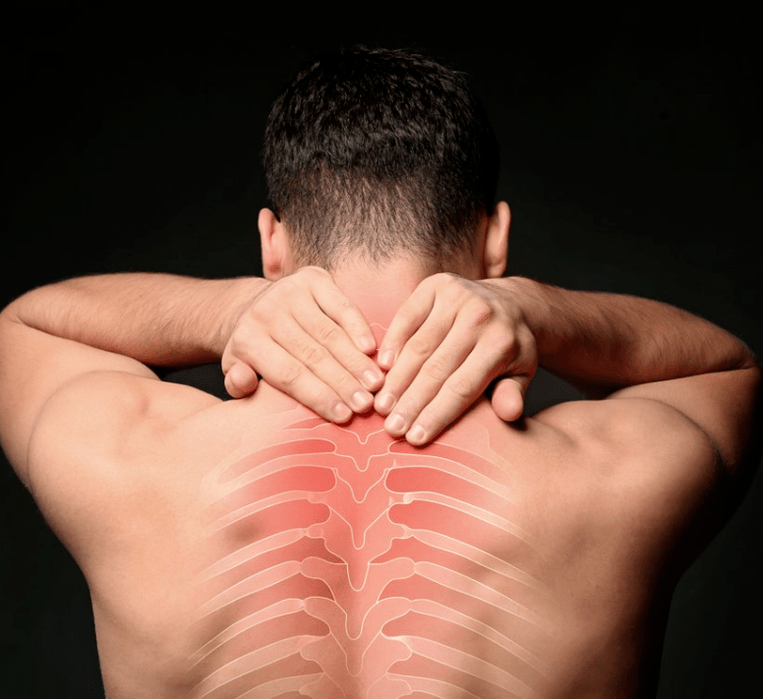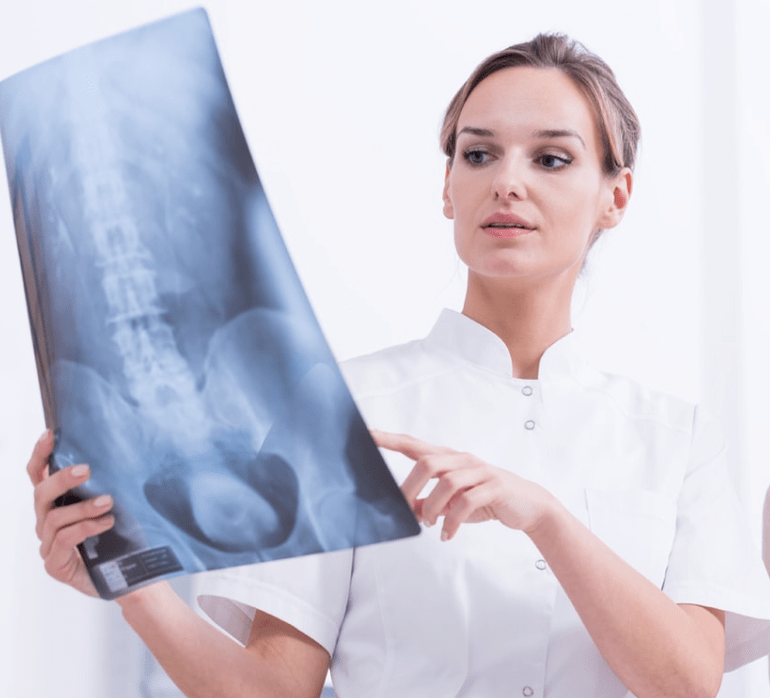
Osteochondrosis is the most common disease of all spinal diseases. Because osteochondrosis is a dystrophic-degenerative change in the plates between the vertebrae directly, this results in an irreversible change in their structure as well as in the shape of the plates that make up the thoracic spine.
As a person ages, these changes in their spine develop more and more, and by the age of about 40-45, almost everyone suffers from osteochondrosis of the spine. Osteochondrosis of the thoracic spine alone is much less common than, for example, the lumbar or cervical spine because the vertebrae in it are much less mobile than in other vertebral areas. In addition, there is a more advanced muscle corset on the back of the chest that supports the spine much better in the chest region than in others.
What is chest osteochondrosis?
Chest osteochondrosisdirectly represents the stratification of intervertebral discs, with a concomitant decrease in their thickness and, consequently, a subsequent pinching of nerve endings located in the intercostal zone of the human chest.
However, it is again noted that because the physiological fixation of the ribs in humans is quite rigid, osteochondrosis of the chest spine is the least sensitive. Chest osteochondrosis is a rare phenomenon, such as cervical or lumbar osteochondrosis.
In general, with osteochondrosis of the thoracic spine, the pathological process involves discs between the vertebrae of the thoracic spine that contain twelve thoracic vertebrae. But most often in osteochondrosis of the thoracic region, abnormal lesions occur in the upper thoracic vertebrae. There are several degrees of lesions in thoracic osteochondrosis, and these will be examined in more detail.
Predisposing factors for the development of thoracic osteochondrosis
The exact causes of osteochondrosis of the chest region have not yet been fully established by modern science. It is currently common practice in medicine to distinguish between the following predisposing factors, or so-called risk factors, that cause osteochondrosis of the thoracic region in the spine:
- hereditary predisposition;
- excessive physical activity at this stage of the spine;
- spinal injuries such as falls or bruises in the chest region;
- changes in the intervertebral discs with advancing age and lead to a decrease in hydration of the tissues of the discs;
- violation of the blood supply in the chest area.
Causes that contribute to chest osteochondrosis disease
In particular, the development of osteochondrosis disease is usually promoted by hypodynamics, i. e. the lack of muscle load, which leads to a weakening of the functions of the muscular corset and, as a result, to an increase in the load. intervertebral discs and tapes.
Other causes of chest osteochondrosis include:
- hypothermia of the body;
- the presence of chronic stressful situations;
- transmitted infections;
- difficult working conditions;
- hormonal disorders in the body;
- violation of the metabolic process in the body;
- the presence of congenital disorders of the spine, namely the chest region.
Exposure to a combination of these factors, or sometimes even to one, causes dystrophic-degenerative irreversible processes in the intervertebral discs over time:
- the pulp of the core of the intervertebral disc gradually begins to lose out of the fluid they have chosen to provide lubrication function, which ultimately significantly reduces the damping function of that disc;
- the fibrous ring of the vertebrae becomes more vulnerable due to the load placed on it, leading to gradual destruction.
Symptoms and signs of chest osteochondrosis
The clinical symptoms of osteochondrosis of the chest depend entirely on the following factors:
- the age of the patient;
- the rate of development of the disease;
- stages of osteochondrosis of the thoracic spine: remission or exacerbation.
The main signs of chest osteochondrosis are:
- pain in the chest in the spine, called dorsago;
- painful damage to the nerve endings of the spinal cord - radiculopathy;
- abdominal syndrome;
- heart syndrome or changes in the heart muscle, with characteristic pains that persist even under the influence of trinitroglycerin;
- pulmonary syndrome, in the form of stagnation in the lungs, with signs of hypoxia, i. e. , suffocation.
No increase in body temperature is observed in a patient with osteochondrosis of the chest, which is also a direct differential diagnostic sign. Dorsalgia in the chest area, as one of the main symptoms of osteochondrosis, indicates the occurrence of cracks in the annulus fibrosus and deformity of the nucleus pulposus. When touched, the pain in this chest area only intensifies, the symptoms intensify.
In addition, characteristic symptoms of thoracic osteochondrosis with compression myelopathy, i. e. deformity of nerve endings:
- "goosebumps" sensation - paraesthesia;
- pain along the compressed nerve - common symptoms;
- decreased temperature and touch sensitivity;
- spinal motor dysfunction is also one of the characteristic symptoms.
If you experience such symptoms, you should consult a specialist. The appearance of symptoms in the complex and their intensity are particularly dangerous. However, it is not appropriate to treat the symptoms without eliminating the causes and factors of the disease.
Degree of osteochondrosis of the chest
Each stage of thoracic osteochondrosis disease is characterized by its own pathology, which has only its own clinical symptoms. Modern medicine distinguishes between four degrees of degenerative disc disease of the chest region (similarly - lumbar and cervical degenerative disc disease) and, accordingly, four developmental periods. Let's take a closer look at them.
First degree,characterized by cracks appearing inside the fibrous ring into which the pulposus nucleus later penetrates. This period of development of thoracic osteochondrosis disease is characterized by the following symptoms:
- the appearance of pain in the spine that does not go beyond the localization of the lesion;
- these pains may be persistent or may be expressed by lumbago;
- spasmodic contraction of the muscles of the chest region may occur, accompanied by pain in the heart region.
Second degreethe development of thoracic osteochondrosis is characterized by an abnormal incidence of increased intervertebral mobility with the following clinical manifestations:
- subluxations appear in the thoracic spine;
- pain increases during movement;
- discomfort occurs with prolonged posture.
Third degreeit is characterized by rupture of the annulus fibrosus and exit beyond the boundaries of the nucleus pulposus. During this period of the disease associated with osteochondrosis of the thoracic spine, intervertebral hernias begin to appear, the clinical symptoms of which are quite severe. Namely — neurovascular, muscular, and reflex dystrophic.
In addition to the above, the third degree of osteochondrosis of the thoracic region is characterized by a change in the following condition of the spine:
- poor fixation of the position of the spine;
- restriction of spinal region mobility in the form of kyphosis or scoliosis.
Fourth degree- the dystrophic-degenerative process already affects all structures surrounding the spine. This pathological process involves yellow, interspinous, and other ligaments, and fibrosis occurs in the structures surrounding the spinal column. During this period of osteochondrosis of the chest, the so-called remission state can be observed clinically.
Complications
With the further progression of osteochondrosis of the chest, concomitant complications are possible:
- inflammation of the nerve endings in the spinal cord;
- occurrence of intervertebral hernias;
- development of vascular dystonia;
- Schmorl's hernia formation;
- spondyloarthrosis disease;
- abnormal growth of bone growths - osteophytes;
- significant reduction in the spinal canal.
It should be noted that the severity of complications in thoracic osteochondrosis depends entirely on the rate of progression of the underlying disease process and, of course, the effectiveness of methods for treating osteochondrosis of the thoracic spine.
Diagnosis and methods

In practice, several methods are used to diagnose thoracic osteochondrosis. The most common of these is the X-ray examination, the results of which are quite informative. Signs of chest osteochondrosis seen in the study include:
- the outlines of the plates between the vertebrae were broken;
- the edges of the motherboards were given a wavy character;
- the intervertebral discs changed their shape;
- osteophytes appeared - bone pathological growths in the spine;
- the hook-shaped processes of the vertebrae are increased and sharpened;
- the body of the thoracic vertebrae changed its normal shape;
- the height of the intervertebral discs was significantly reduced;
- disc herniation developed between the vertebrae.
In some cases, the method of diagnosing thoracic osteochondrosis of the spine is practiced using an X-ray contrast scan, which determines the following signs of the disease:
- in advanced pathology, the contrast agent completely fills the intervertebral disc;
- contrast material shows the outlines of the nucleus pulposus, which are uneven;
- when the intervertebral disc is destroyed, the contrast material penetrates greatly beyond its boundaries, all the way to the spinal cord.
Only the correct diagnosis will determine the appropriate treatment.
Treatment of osteochondrosis
Treatment of thoracic osteochondrosis is possible by one of the following methods, which are used taking into account the diagnostic results of thoracic osteochondrosis, namely:
- conservative-traditional treatment of the spine;
- treatment of chest osteochondrosis by pulling;
- operative surgery.
Treatment of chest osteochondrosis, called conservative, is complex to treat any type of osteochondrosis: medications, physiotherapy, physiotherapy practices. Nonsteroidal anti-inflammatory drugs are designed to relieve spinal pain, which is known from chest osteochondrosis. It should be noted that these drugs very well eliminate inflammatory processes, as well as the resulting swelling, help reduce the compression of nerve roots. In more complex cases of breast osteochondrosis, your doctor may prescribe a number of additional medications, such as some strong painkillers and muscle relaxants, that block the appearance of muscle cramps.
When the pain recedes or has been eliminated, i. e. , during remission, physiotherapy is prescribed, as well as exercise therapy and massage. These are all important elements of comprehensive management. One of the main physiotherapy tools for the treatment and prevention of the disease is pulsed magnetic therapy, which uses special medical devices for clinical and home use.
During exacerbations, only magnetic therapy with special parameters is allowed; there are medical devices to treat acute and chronic pain. This system is also suitable for the treatment of the lumbosacral and cervical spine.
In addition to the above, traction therapy, i. e. the treatment of chest osteochondrosis with special traction, can be successfully used for the treatment of chest osteochondrosis. With this method, the paravertebral muscles, tissues, and ligaments are stretched, leading to an increase in intervertebral distance. Even a millimeter and a half will be enough to reduce swelling, eliminate compression, and relieve muscle tension in the spine. In any case, the main principle of conservative treatment is complexity. The treatment should be done for a long time and regularly, this is the only way to hope for results.
But surgery, as one of the treatments for osteochondrosis, is only advisable if the above methods of treating chest osteochondrosis do not give the desired result.





































